Easy Buttermilk Biscuits
Buttermilk biscuits made from scratch are incredibly easy and come out tall, fluffy and flaky with just one simple trick. They are wonderful on their own, with a smear of butter, or as a base for sausage gravy, strawberry shortcake, or your favorite breakfast sandwich.
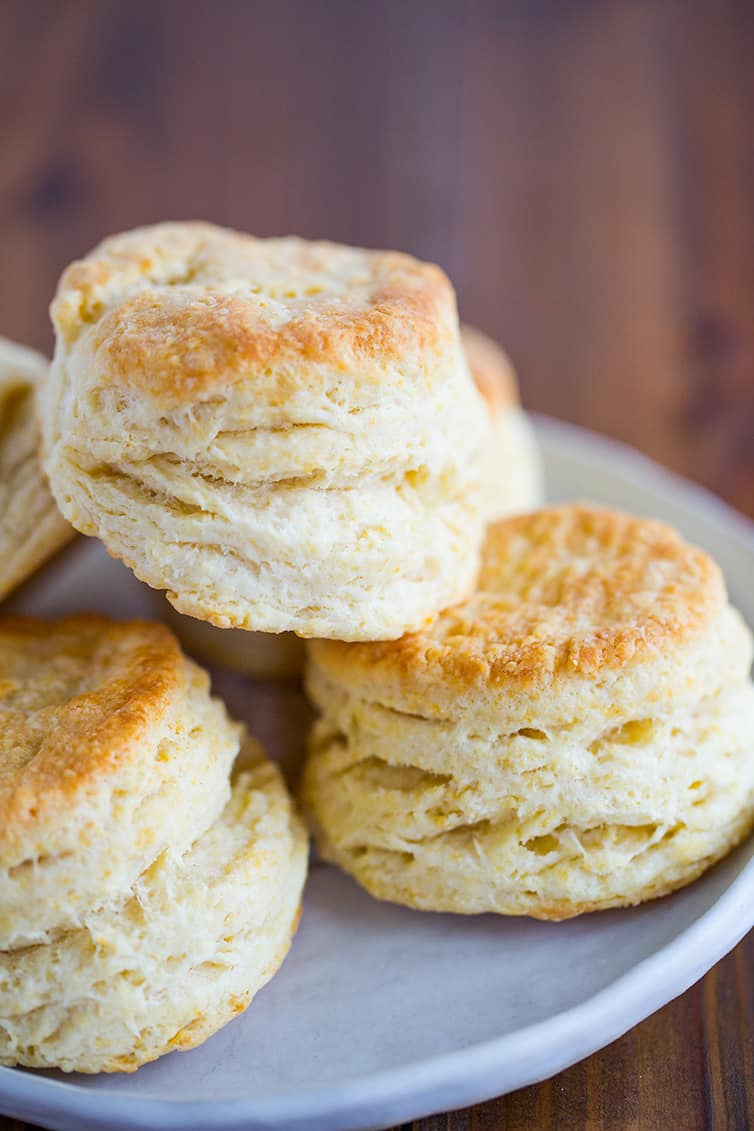
I think you all know by now that I am a total carbaholic, so it probably comes as no surprise that I absolutely adore biscuits. I don’t make them often, though, reserving them for special occasions or a treat when out for breakfast or brunch. Like anything that is only consumed once in a while, when you DO eat it, you want it to be absolutely phenomenal.
The biscuit recipe I have been making for the better part of ten years was always fine, but most definitely not phenomenal. They were good, but not mind-blowing. I wanted sky-high biscuits with umpteen buttery layers, and I’m thrilled to tell you that they are HERE. With just a few tweaks and simple tricks, I had the biscuits of my dreams.
There’s just something magical about pulling apart that soft biscuit, watching the steam wisp out of the middle, and then savoring each buttery, flaky layer.
I can now enjoy sausage gravy and strawberry shortcakes with reckless abandon!
How to Make Homemade Buttermilk Biscuits From Scratch
Biscuits are one of the simplest baked goods to make, in terms of both ingredients and time, but they have been known to cause even the most even-tempered bakers to pull their hair out.
Light, fluffy biscuits and hockey pucks are separated by a very fine line. Below are some tips to help make sure you end up in fluffy biscuit land, and not on ice…
- Cold butter is key. For biscuits (as well as pie crusts) I find that cubing the butter and then putting it on a plate in the freezer for about 15 minutes before using it keeps it nice and cold while mixing.
- Mixing the butter and dry ingredients quickly so the butter remains cold and firm is crucial to producing light, tender biscuits. The dough will likely be shaggy and rough, and that’s okay; if you work it until it’s smooth it will be overworked and result in tough biscuits. A light touch and little pressure is important.
- Folding the dough envelope-style is the biggest difference I’ve found when re-working my biscuit recipe. It creates incredibly tall biscuits with layer upon flaky layer of buttery goodness.
- When you cut the biscuits, whether with a cookie cutter or biscuit cutter, push straight down, then pull right back up. DO NOT twist the cutter… I used to make this mistake and couldn’t believe the difference it made when I stopped!
- The intense heat of the oven creates the steam needed to raise the dough and create airy, fluffy biscuits. Make sure your oven is completely preheated before baking the biscuits.
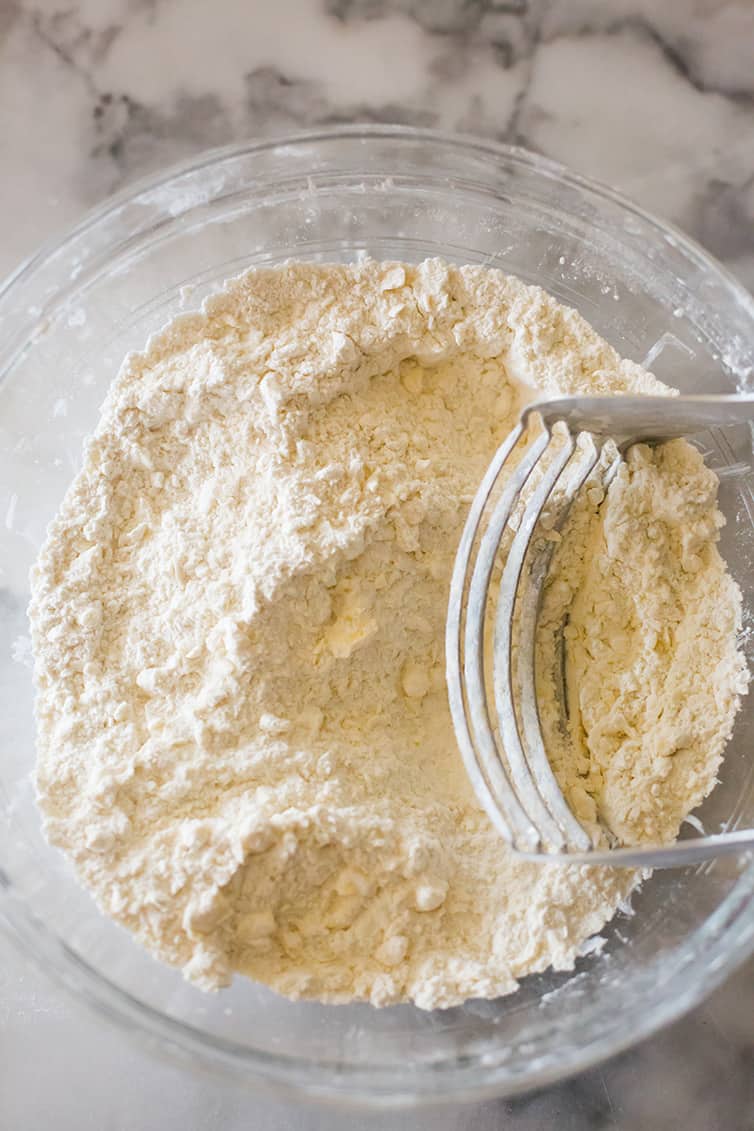
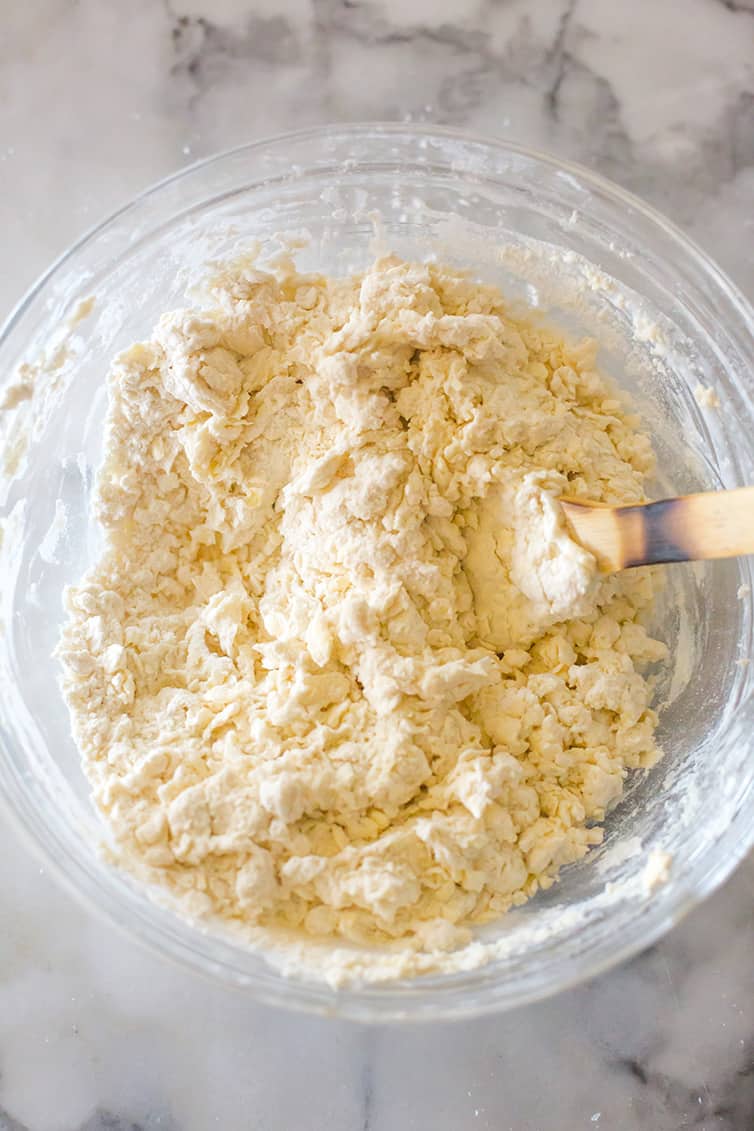
Can Buttermilk Biscuits Be Made Ahead and/or Frozen?
Yes, to both!
While I think there is nothing quite like a biscuit fresh from the oven, you can absolutely make them and then reheat them. In order to get that warm, fresh-from-the-oven taste and texture, I recommend reheating in a 350-degree oven (a toaster oven is perfect for this, too!) for about 5 minutes. Perfection.
If you’d like to prepare the biscuits ahead of time without baking them first, you can do that, too. Simply prepare the dough and cut out the biscuits, then place on a parchment-lined baking sheet, cover with plastic wrap and place in the freezer. Once completely frozen, place the biscuits in a freezer ziploc bag and keep in the freezer for up to 3 months.
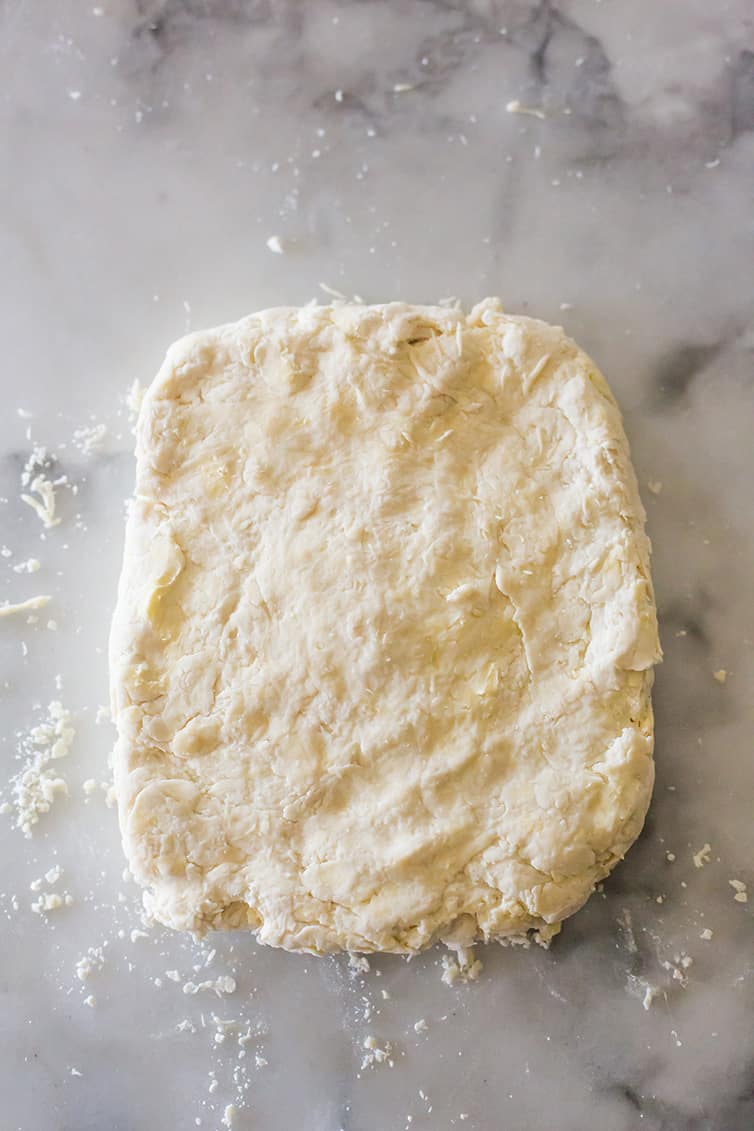
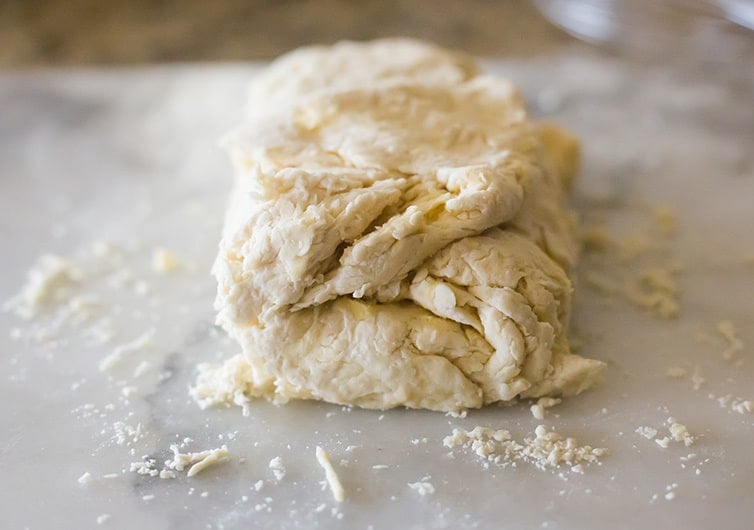
How to Make Buttermilk Biscuits in a Cast Iron Skillet
Easy! Simply place the biscuits in a large cast iron skillet, leaving space between each one so that they have room to grow and rise.
This is a great option if you love the bottom of your biscuits to have a little crisp and crunch to them!
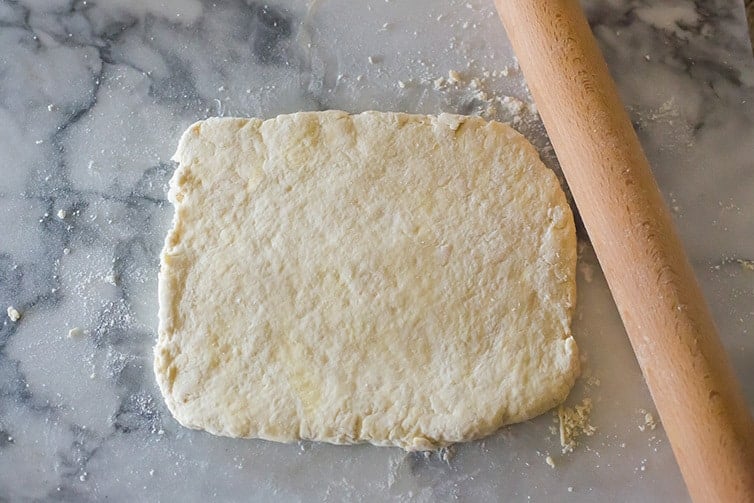
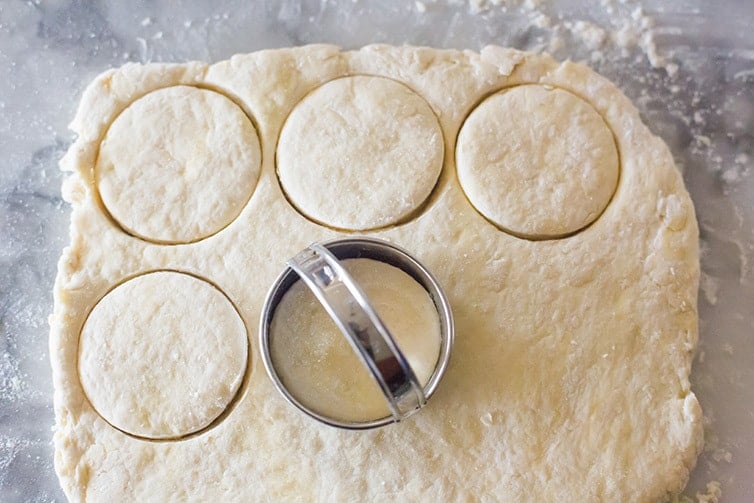
It goes without saying that buttermilk is a key ingredient in BUTTERMILK biscuits, and you might have some questions about it, especially if you don’t use it often.
So, below you will find many of your buttermilk questions, answered!
How Can You Make Buttermilk if You Don’t Have It?
If you don’t have buttermilk on hand, you can easily make it using a combination of regular milk and either lemon juice or white vinegar (this is referred to as “clabbered milk”; here’s how to do it:
Add 1 tablespoon of lemon juice or white vinegar to a measuring cup, then add enough milk to make 1 cup. Stir together, then use as directed in the recipe. (You can scale up if needed; if you do not need a full 1 cup, discard what you do not need.)
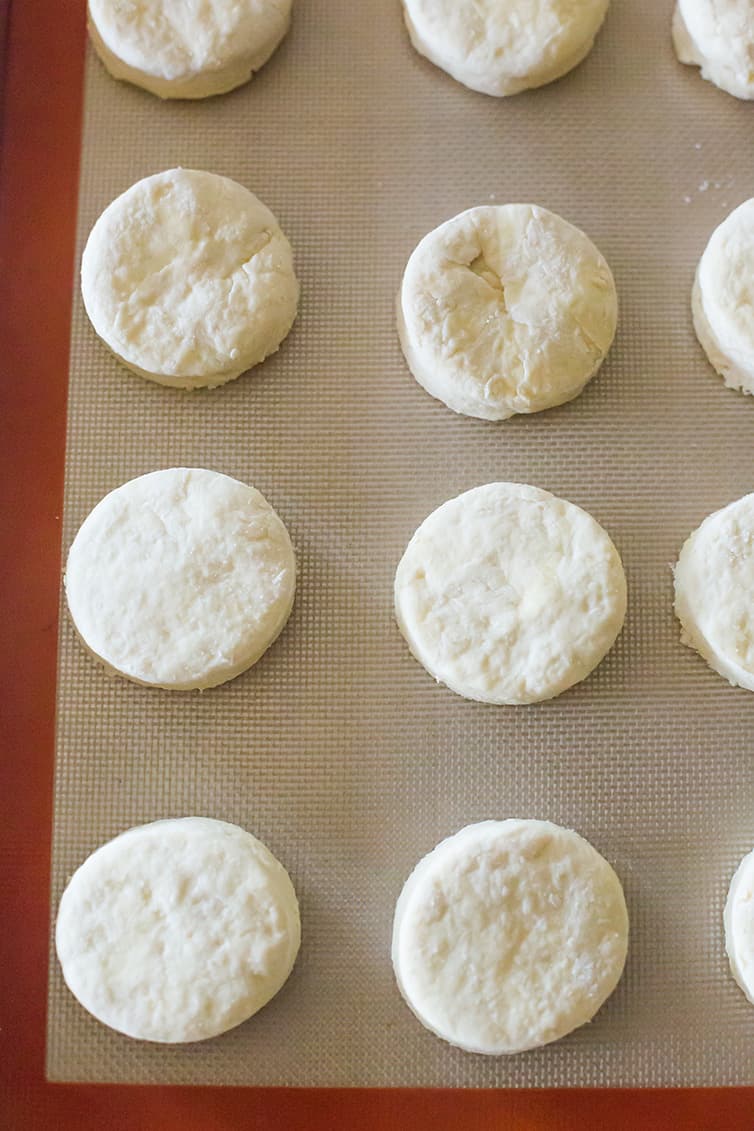
How Can You Tell if Buttermilk Has Gone Bad?
Since buttermilk already has a characteristic sour smell and taste, and it can take a long time for it to actually get moldy, it can be difficult to tell if it has gone bad. And because it is acidic, it will take a long time to actually develop mold.
Buttermilk should typically be used within a couple of weeks of opening it, but if you shake it up and the consistency is “off” from when it was originally opened (super thin or extra chunky), then discard it. Also, if it emits a more foul odor than the traditional sour smell, then pitch it as well.
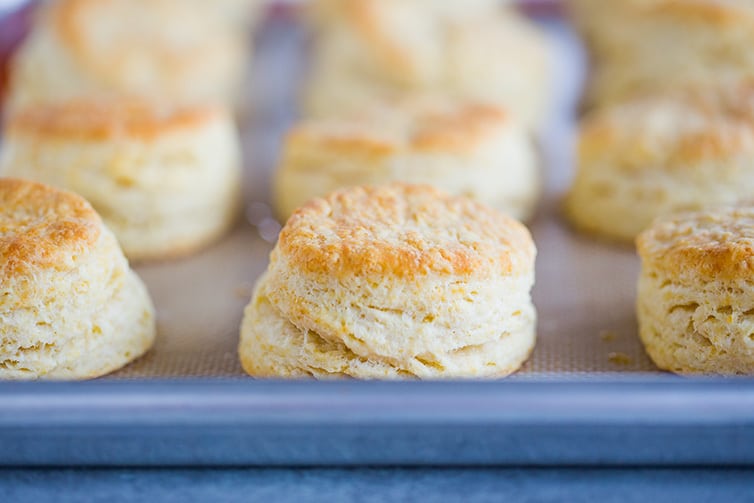
Can Buttermilk Be Frozen For Later Use?
Yes! Most recipes don’t call for more than 1 cup of buttermilk at a time, so I’ve found the best and most efficient way to freeze buttermilk is in 1 ounce (2 tablespoon) portions.
To do this, I love these silicone ice cube trays (also perfect for making homemade baby food!) – once frozen, I pop them out and store in a freezer ziploc bag until I need them. Thaw in the refrigerator and then whisk well to reincorporate the buttermilk (it will separate when frozen).
You can store the frozen buttermilk for up to 3 months.
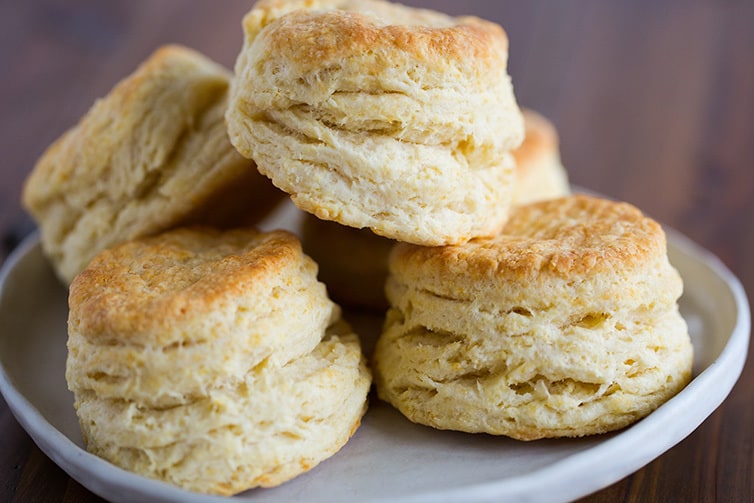
Now, who’s ready to bake some light-as-air, buttery, flaky buttermilk biscuits?!
You now have all of the tools and tips you need to make the most incredible homemade biscuits from scratch. With just a tiny bit of extra time and effort, you’ll never, ever want to pop open a can of biscuits again.
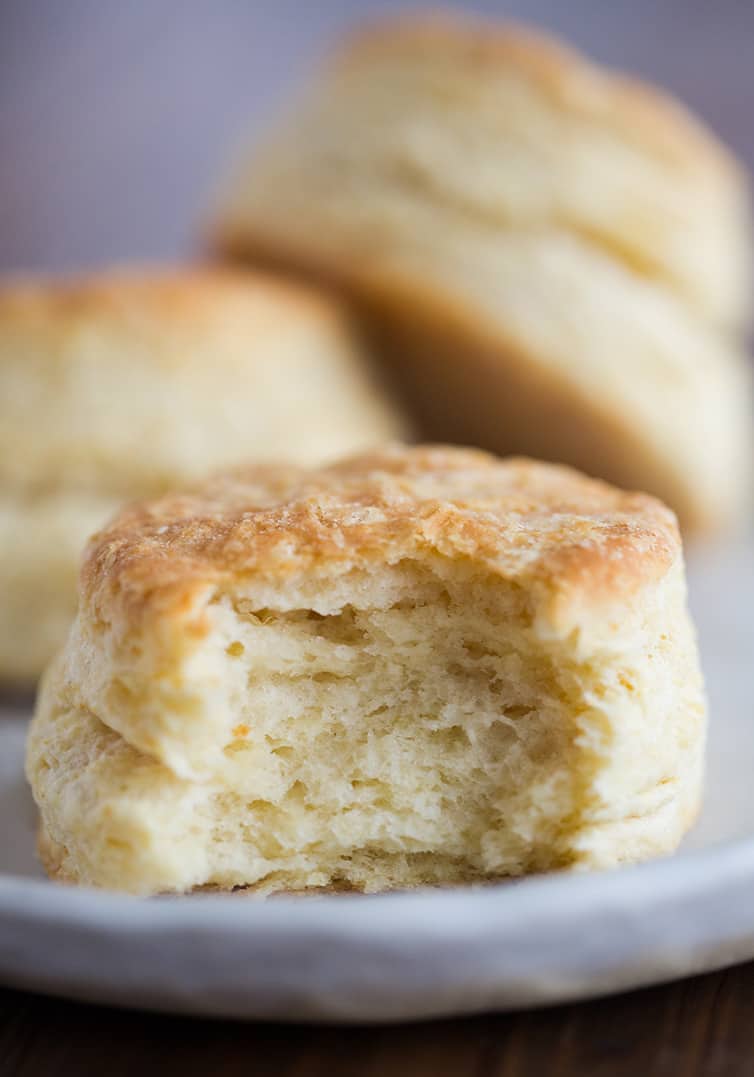
Four years ago: Cookies and Cream White Chocolate Bark
Five years ago: Chinese Beef and Broccoli
Six years ago: Fresh Fruit Tart with Pastry Cream
Watch How to Make Buttermilk Biscuits:
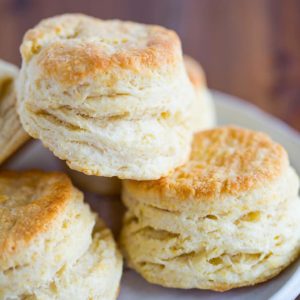
Buttermilk Biscuits
Ingredients
- 2½ cups (312.5 g) all-purpose flour
- 2 tablespoons baking powder
- 2 teaspoons granulated sugar
- 1 teaspoon salt
- ½ cup (113.5 g) cold unsalted butter, cut into ¼-inch cubes
- 1 cup (240 ml) cold buttermilk
- ¼ cup (56.75 g) unsalted butter, melted, for brushing
Instructions
- Preheat oven to 425 degrees F. Line a baking sheet with parchment paper or a silicone baking mat.
- In a large bowl, whisk together the flour, baking powder, sugar and salt.
- Using a pastry blender (or two knives or your fingertips), quickly cut the butter into the flour mixture until the mixture resembles coarse meal with a few slightly larger butter lumps.
- Using a rubber spatula or fork, stir in the buttermilk until the mixture forms a soft, slightly sticky ball.
- Transfer the dough to a lightly floured surface and quickly form into a rough square. Be careful not to overmix. Pat the dough into a 1-inch-thick rectangle. Fold the dough letter-style into thirds, then lightly pat the dough back out into another 1-inch rectangle. Try to handle the dough as quickly and lightly as possible. Repeat the folding 2 more times; after the final fold, press or lightly roll the dough into a ½-inch-thick rectangle.
- Using a 2½-inch round biscuit or cookie cutter, cut out the dough rounds and place on the prepared baking sheet. Pat and roll the remaining scraps to cut out more rounds. Brush with the melted butter and bake until the biscuit tops are light golden brown, 10 to 15 minutes. Brush with additional butter immediately, if desired. Serve warm or at room temperature. The biscuits are best served the day they are made, however leftovers can be stored in an airtight container at room temperature for up to 4 days. Reheat in a 350 degree F oven for 5 minutes.
Notes
Did you make this recipe?
Leave a review below, then snap a picture and tag @thebrowneyedbaker on Instagram so I can see it!


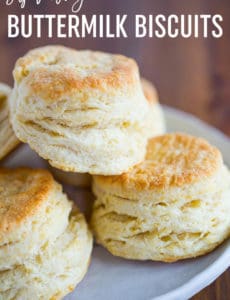
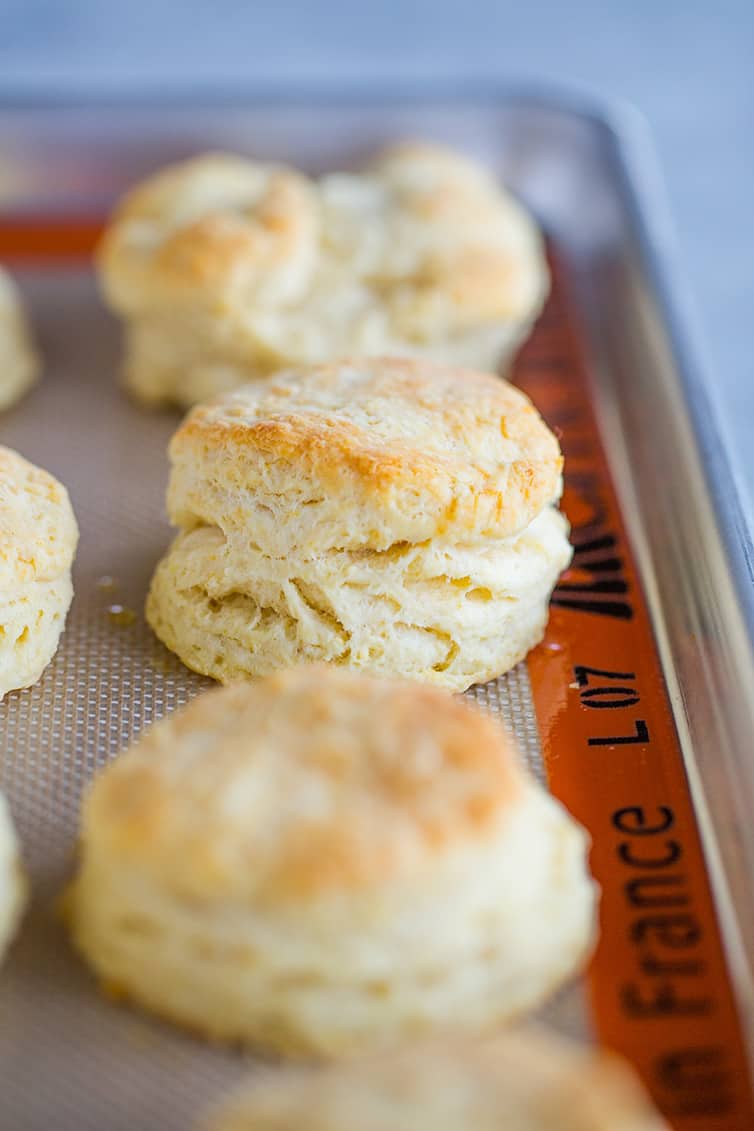



Love the recipe however they did not rise as much as I had hoped
Tender and flaky
These turned out so good. I followed the recipe to the t. First time making biscuits.
I’ve made this recipe many many times. I get better with practice :) Tasty and habit forming! Her tips are very useful. I eat alone with peach jam or serve when I make fried chicken and milk gravy. I put leftovers in a ziploc baggie in fridge and reheat in oven next day or so. Gets tastier, easier and quicker to make with repetition. So make them every day ;)
Easiest and best ever. I have used white vinegar and rice and rice plumps higher for some reason.
Thank You, for recipe & looks like very simple recipe surely i bake this weekend
These delicious biscuits made our Sunday morning special. I was out of bread and needed to use up some buttermilk. These are easy to make and taste incredible. I missed the part about freezing the uncooked biscuits, but these reheated just fine.
The only negative is they’re so good you’ll want to eat so many. I used site soured half n half. That’s actually why I made these, because I didn’t want to waste the half n half. 😏 They are light fluffy and flaky. So good.
Sorry couldn’t edit so I’m correcting my post by replying. It says site soured, it’s just soured. Crazy fingers I guess.
So simple and absolutely delicious! Best recipe I have ever tried. My husband cannot get enough of them. Thank you for sharing.
I have White Lily self Rising flour. do I need to adjust or leave out anything?
After cutting them out can you freeze the biscuits for future use?
Yes, you definitely can!
One word…. Awesome! I patted the dough out on parchment paper and it was so easy to do the folds with the least handling of the dough. The very best buttermilk biscuits ever. Like yummy golden clouds of perfection. Thanks a million.
You share THE tastiest recipes!! (Also, easy). Who says that it has to be hard work to create a great tasting dish/meal!!! Thank you for sharing your wonderful recipes!!
Super easy and the flavor and texture were great. I wish they were a little taller so I think I’ll make six instead of 12 next time.
Very good. Highest biscuits I have ever made. Light & flakey with a buttery flavor.
Forgot to say that I used the buttermilk powder & grated my butter.
I plan on making my own Buttermilk Is that going to work in this recipe
Yes, absolutely!
Hello –
I tried this last night. They were spectacular. I have made many biscuits and scones in my life and this recipe is the best.
Spectacular!! They turned out perfect and were so delicious!!
Hi! After reading all the comments, I am planning on making these for our breakfast Thanksgiving morning (we have breakfast with parents in the morning as we prep the turkey for dinner and watch the Macy’s parade so it’s a special breakfast). I am wondering if it’s possible or anyone has prepped the dough the night before and refrigerated it, then rolled it out that morning to bake fresh?
Dynamite! I love this recipe.
These are amazing. They remind me of my grandmother’s biscuits. I ran out of regular flour and tried wheat flour. They were just as amazing but had a lovely grainy texture.
Wheat biscuits, who knew? Still…regular flour or wheat flour this will always be my favorite recipe.
Best biscuit recipe!!!! I’ve tried many, but BEB, yours is TOPS!!! Love the crunch from the bottom of the biscuits. YUM!
What’s the cooking instructions for when you’ve frozen them prior to baking them?
Great recipe, I also grate frozen butter as another commenter said too!
Hi Tricia, Thaw the biscuit dough overnight in the refrigerator, then bake as directed. Enjoy!
I made these this morning and they are SO GOOD! Easy and quick to put together, too!
I love your recipe, but I feeeze my butter and grate it into the dry ingredients so there is much less working it together.
I love this recipe, but I grate the butter in instead of cutting with a pastry blender, and I cut the biscuits with a knife instead of a cutter. Delicious either way!
I freeze my butter and grate my butter with a box grater. Comes out perfect and less work
I don’t have instagram, so I can’t drop you my picture – BUT! I did take a picture because of how proud I was at how well they turned out! My first time making biscuits from scratch and WOWZA! Your description of sky high did not disappoint :D I have made these 3x now and each time, they have come out perfectly softy, fluffy, moist, and delicious! I used my kitchen aid (spatula’d spade shaped paddle to break up the butter in the flour mixture, then switched to the dough hook for the buttermilk. So easy! Thank you so much for posting ;-)
Can you give metric measurements beside the American way? Baking is chemistry so I believe exact measurement is part of the key.
My favorite go to biscuit recipe. My family loves it EVERYTIME I bake it.
I have not tried the Buttermilk Biscuits yet but saw you suggested they can be frozen before baking. Do the biscuits need to be defrosted before baking if the are frozen and then baked 10-15 minutes? Or can you bake them while they are still frozen? If so, how long?
Hi Anne, You can bake straight from frozen, they may just need an extra few minutes.
I will try these at home.
hello Brown Eyed Baker I’m wondering for biscuits buttermilk biscuits or angel biscuits instead of baking powder or baking soda or combinations thereof can I just add in a package of yeast thank you
Hi Glen, I’ve never made angel biscuits, but for these biscuits I do not recommend using yeast.
Hello Michelle :) Has the amount of baking soda in this recipe changed as of 3/27/2019? Is it still actually 2 tablespoons of baking powder? I noticed several comments questioning the amount of baking soda. Thanks for answering this.
I updated this recipe in June of 2018, no changes made since then.
I’m guessing those commenters used 2 tbsp baking SODA, not baking POWDER. Soda should be substituted for powder of about a 1-to-3 ratio–that is, two TEASPOONS of SODA.
I made the same mistake the first time I made these… I salvaged it by drinking a lot of fruit juice at the same time as I ate the biscuits, which made for fizzy juice rather than bitter biscuits.
The recipe as written is perfect, though. I’m addicted to these biscuits.
I have used this recipe 3x now, and I use the 2 Tablespoons. It’s wonderful! I read one review on this where someone said they were bitter, but not one person from my family of 5 was anything less than ‘in awe’ of these biscuits. It’s truly the perfect buttermilk biscuit recipe!
These are spectacular! Very popular when I make them in our home. I’ve never made a batch to freeze and plan on trying that. Once I’ve decided to bake the frozen ones, do I need to thaw them first or bake from frozen?
Why do your older commentators mention using cake flour? Is this something you changed and if so, why?
Hi Lola, Yes, I completely revamped the recipe.
I made these for breakfast this morning and they were delicious! Tender and buttery and I could have eaten the whole tray. Baked up beautiful and tall. I was out of buttermilk so I used 1t of vinegar and enough milk to make the cup called for. Worked like a charm. These will be my go to biscuits from now on.
Made these last night and they were amazing!!! I’ve tried so many biscuit recipes, but I’ve just never been happy with the results.
These are my new favorite!!
A few things I did was, I grated in my freezing cold butter, and after I added the butter, I put my bowl into the freezer for a few minutes to make sure the butter mixture stayed cold.
Then I carefully rolled it into a rectangle and cut that into 12 squares, instead of cutting circles. I thought the less I messed with the dough, the better.
And, square biscuit tasted fabulous! Thanks, Michelle!!
These are very tasty and easy to make.
I agree these are very light and fluffy.
I hesitated when I followed the recipe. 2 tablespoons of baking powder? But I said, I need to follow her recipe. In all my days of baking (50+years) I have NEVER used even 1 tablespoon of baking powder in a recipe.
I was excited when they came out of the oven. One taste and I gagged with the bitterness of the baking powder. I hope this was a typo. Even 2 teaspoons seems like a lot.
Robert
After freezing unbaked biscuits, at what temperature and how long do they need to bake them? I baked some before putting the rest in the freezer and they were fantastic! My new favorite recipe!
Hi Linda, I would bake at 475 for 5 minutes, then reduce to 425 and bake for another 10 minutes or so, until golden brown. I’m so glad you enjoyed them!
So delicious, best home made biscuits I’ve ever made, and easy!
These look amazing!
Question…Do i have to alter the recipe for high altitude?
Hi Maida, I’ve never made these at altitude, so I cannot say for sure, but this is a great resource guide for what you may need to adjust: https://www.browneyedbaker.com/high-altitude-baking-tips/
I thought that you need baking soda and baking powder when using an acid liquid like buttermilk
Hi John, Baking powder is actually made up of baking soda + cream of tartar, and sometimes cornstarch. So you’ll still get a reaction/rise from from the buttermilk!
These biscuits look dandy! I noticed there was no baking soda used? Most recipes I’ve dealt with that use buttermilk calls/requires for some baking soda to be added.
Hi Mack, That’s true, although it’s not necessary. Baking powder is actually made up of baking soda + cream of tartar, and sometimes cornstarch. So you’ll still get a reaction/rise from from the buttermilk!
Made these today, so easy, tasty, buttery, and my dogs loved the scraps. Thank you!!
Followed this recipe today and produced tasty biscuits. Very easy to follow and my biscuits looked good and tasted great. Thanks.
If I freeze before baking, should I thaw completely or maybe bake partially frozen for more rise?
Hi Anne, No need to thaw, you can bake from frozen, just add a couple of minutes!
I can’t wait to make these. I’m never good at “cutting in” the butter with a pastry blender, so when making scones I would freeze the stick of butter and grate it. I could then mix it in with a fork and get the right consistency. Works every time for me so I will try that with this recipe!
Congrats on your growing family! Love seeing the pics of your adorable kids and your goldens! We have a 9 year old golden, Zoe.
Can you use dry buttermilk reconstituted?
I add the buttermilk powder with the dry ingredients then use water when you would use buttermilk. I love that I always have it on hand, I just store it in the frig after opening.
Hi Cathleen, I haven’t, but love Mary’s tip below!
I use Buttermilk powder for baking and absolutely want King Arthur unbleached cake flour when cake flour is called for.
Have you ever used the powdered buttermilk? I use it for pancakes, but not sure what else to use it in.
Hi Jan, I have not!
I store my unsalted butter in the freezer. For biscuits, I grate the frozen butter into my bowl of flour and proceed as directed. Easy peasy!
Hi Michelle, I use a flat grater and butter from the fridge then just stir gently with hands if needed I put the whole load of dry ingredients in the freezer…more flakes of butter I’m with you on all the other tips…they’ve made mine incredible!
Thanks so much for the tip!
I always keep a tin of powdered buttermilk in the fridge. I can’t stand the taste of it so won’t drink it straight, but I can’t deny buttermilk’s necessity when baking some things. The powdered lets me only prepare what I need when I need it. And at ~$5 a tin, it’s very economical as well! Can’t wait to try this recipe, as biscuits are one of my favorite things on the planet as well!
I’m confused reading the comments – referrals as to different types of flour and the reference to this being a recipe from America’s Test Kitchen. What am I missing in this posting?
Hello! So sorry for the confusion – I originally published this post nearly 10 years ago, but have re-worked the recipe and re-published it this week. I will add a note to keep confusion at bay!
I agree – I always have sky high expectations for biscuits, but so many are meh. I want the layers to be as high as my expectations I guess, hehe. Appreciate the cold butter trick and can’t wait to try these!
Just out of the oven and fabulous. Best recipe I have ever tried for biscuits. Thank you so much for all the tweeking to get it perfect for the rest of us.
Hi Susan, Yay! I am so thrilled to hear that!
I just tried making biscuits from scratch and they tasted great but didn’t have quite the airy, light texture and high rise I was hoping to get. Your tips are all helpful and probably the reason mine didn’t turn out quite right. Thanks for sharing!!
I’m confused a bit . . . . reading through the reviews, I’m seeing some that talk about a combination of flours, some that say cake flour, and yet the recipe says all purpose flour . . . . HELP! I want my biscuits to look like yours (have yet to achieve that goal), so getting the flour(s) right is important. Also, was wondering if you have ever used White Lily flour for your biscuits. The biscuits you made look fantastic, and now with strawberries just coming into season (just yesterday bought 2 qts from the local farmer’s market) I need to . . . must . . . make these ASAP :)) Hope you’re doing well.
I noticed that too, reading through the reviews. I use AP flour (organic) for my biscuits. Works great! And, if using biscuits to serve Strawberry Shortcake-style, like another reviewer said, increase the sugar from teaspoons to tablespoons. I loved the biscuit in place of cake for strawberry shortcake!
Hi Michelle, This is a recipe that I posted nearly 10 years ago, but totally reworked and re-published this week. I’ve never used White Lily flour!
I have never been able to master biscuits, but will definitely give these a try. So glad you are back with new recipes but so glad you took some time with your new sweet girl and your precious boys.
Looks absolutely perfect for weekend brunch!
These are just wonderful! Where I live in the West, it is impossible to get southern flour–like White Lily. AP flour has always led to hard tack biscuits for me. The mix of the flours–and measuring by weight–worked great!
I used this recipe last night to use in making strawberry shortcakes. Instead of using 1 t. sugar I used 1 T. The biscuits came out tender and absolutely delicious. Not too sweet.
Another thing that i did differently from what I usually do was that I used my new Danish dough hook instead of the food processor.
The biscuits did not rise as tall as I was expecting but that was fine by me. This might be due to the fact that I don’t even know how old my baking soda/baking powder are and not the recipe’s fault.
Hey Michelle, I attempted to make these last night because, like you, I’m obsessed with carbs and could live on buttermilk biscuits. (Cracker Barrel, Popeye’s, KFC…any are good, but my absolute favorite are McDonald’s. Go figure. But I digress.) Unfortunately, I followed all the directions but they were flatter and were not light and fluffy. I mixed them by hand instead of using the food processor. Just wondering if you’ve tried both ways and had more success with the food processor? It occurred to me that possibly the butter got too warm from me using a pastry cutter to mix it into the dry ingredients. I would love to know where I may have gone wrong, although it might not be good for my waistline. ;)
Hi Steph, If they were flat, they definitely could have been overworked. I’ve made biscuits both ways (food processor and by hand). The key to either one is to work very, very quickly. Also, I put the butter in the freezer before using it. You might also want to make sure that your baking soda and powder is fresh; that could affect the rise, as well.
Thanks! Considering the fact that I didn’t have the butter in the freezer for a whole 15 minutes, in addition to the fact that both my baking soda and baking powder is definitely not as fresh as it could be, I definitely have several things to try for next time.
I LOVE these! I am a huge fan of America’s Test Kitchen so finding out that these came from there made me love them even more!
I just made these for a Thanksgiving dinner last night in Italy, near Assisi. You know when you get compliments from Italians on food, you have a good recipe. :) I didn’t think I could love anything more than your chocolate chip cookies recipe, but these got close.
SO GOOD! I have never been so proud of something I made! They were PERFECT!
I made these. My first time making biscuits and they sure were tasty. I made half of the salt rock sea salt. Only thing is mine turned out a very yellow color and they did not brown very much at the top. Does anyone know why? The buttermilk was a few days passed the sell by date.
Best biscuit I have ever made! I posted about it on my Facebook and blog, and linked this website.
Just came out of the oven – delicious! And really easy – I followed the the “by hand” method since I only have a mini-food processor and they came out perfectly fluffy.
Hi, I have a question, can I use this recipe to make “Monkey Bread”? Believe it or not in my country they dont sale the refrigerated one so i have to make it from scratch. Thanks
Hi Ginnette, I actually have a recipe for homemade monkey bread!
https://www.browneyedbaker.com/2010/08/27/monkey-bread-recipe/
It’s fabulous; enjoy! :)
Just made these biscuits tonight and wanted to tell you how wonderful they turned out. They were perfect, thanks for the recipe it’s a keeper.
These look really great. I am having trouble finding cake flour. Where can I get this?
Hi Teresa, You can find cake flour in the baking aisle next to the all-purpose flour. A couple popular brands are Swan’s Down and Softasilk.
These are delicious! I made these tonight with chicken. The biscuits melt in your mouth!
I’m glad someone else has an obsession with carbs! Whenever I make bread we make an extra loaf just to eat it as soon as it comes out of the oven.
Finally dove in to this recipe tonight, it’s divine! The cake flour really sets it apart from other recipes I’ve used in the past. The biscuits rose to be light and fluffy, but I still got a little bit of that crunchy top on them. I made these in the food processor and it couldn’t have been simpler! And those little pockets of butter in the biscuits… yum! This recipe has definitely replaced my old ones!
Wow! Now those are the real deal, thank you for sharing! Awesome photos!
one of my wishes in life is to be able to make delicious biscuits. ive tried so many biscuit recipes that turned out hard as hockey puckets that its not even funny. i may try this recipe & cross my fingers–the photos look delicious.
Beautiful presentation. I’d rather have these carbs than those manufactured ones injected with all types of chemicals. These would be great to munch on while reviewing Foodbuzz posts from fellow food bloggers :)
I respect a woman that can admit she loves carbs. And these biscuits look like the best kind of carb :)
those are gorgeous biscuits!!! your images are amazing!!!
I’m from the south and I do love good biscuits!!
thanks for sharing
Great overhaul on the site (although I also liked it before) — and these biscuits will be on the table this week!
Your blog layout is looking great! So do these buttermilk biscuits. Such a versatile recipe.
Great classic! They look yummy:)
Oh these look scrumptious. Reading this at breakfast time is really a problem. ;)
Love the new look of your site!!!
Thanks for the tips! I don’t have much biscuit experience, having grown up in a country where rice was the staple. I’ve heard so many people lament the fickleness of biscuits, so I really like how you explained the pointers and the reasoning behind each one.
Your buttermilk biscuits look great! I’ve never made them before so I appreciate the tips, thanks!
i love carbs too !! and these biscuits look so yummy and easy to make
Can’t go wrong with a good ole’ Buttermilk Biscuit!
…Mom loves to make her own biscuits, so I gave her this recipe and told her your baking tip of the cold butter…well, she just made them this morning and OMG, it makes a whole world of difference, the cold butter; she did it just as you suggested, put it for about 15 minutes in the freezer…these are the most delicious biscuits ever; please keep them coming, great recipes and great baking tips!…
I love a good biscuit, especially for strawberry shortcake. Although when I’m using them for shortcake I add some finely chopped crystalized ginger to the dough and I sprinkle them with coarse sugar before baking – MMMM. Our strawberries are just coming ripe in the garden so we’ll be eating lots of this in the next couple weeks.
I love that you love carbs. And I love these!
We call them English Scones. Yours looke flaky and soft, must eat them warm and with a cup of hot coffee or tea, yes, yummy!
These look delicous! A biscuit warm from the oven with some butter and strawberry jam – my version of heaven!
Um, you are in love with carbs because they are the BEST FOOD EVER. From one carb-addict to another, thank you for the gorgeous flaky biscuit recipe and tips!
Great tips for successful biscuit-making. And I agree – they must be eaten warm, straight from the oven.
Biscuits are one of my favorite foods in the whole world… And these look perfect!
Mmmmmm. Buttermilk biscuits make the best strawberry shortcake! These look like my mom’s but she never uses a recipe- it’s very frustrating to ask her how she makes anything. (“Well, I just dump it in ’til it looks right.”) :) Yours look delicious.
Buttermilk biscuits are the best! These look delicious!
I am a sucker for buttermilk biscuits and these are no exception. YUM!
these biscuits looks so tasty!
My mom’s buttermilk biscuits are much simplier. This is the recipe I grew up with and it’s something you have to make often in order to understand what the consistency of the dough should be like etc. For us, the older the buttermilk the better the flavor in the biscuits too.
2 c self rising flour
1 c buttermilk
1/4 c veggie oil
That’s it. Just don’t over work the dough. Bake at 450 for 10 – 12 mins.
Another thing I learned from Rachael Ray actually – you can mix into the biscuit dough – eggs scrambled, cheddar cheese shredded, and sausage cooked and broken up into small pieces (or cooked bacon). Then drop them onto a cookie sheet the size you want. These make great grab and go biscuits in the morning. They microwave well.
Yumma Yumma! These look so good :)
Thank you for sharing that recipe, because I cannot make biscuits if it would save my life. The last time I tried, I ended up with flat, hard, cracker-like things. Sooo sad! I’m going to try your recipe though!! :)
Strawberry shortcake? Yes please!! I could go for that right now!
I also think that its a must to eat biscuits while still warm from the oven, so necessary ;)
I too am a carbaholic. My husband makes fun of me. Ah well, he has other redeeming qualities.
The only biscuits I’ve ever made were Ina’s cheddar version – like the Red Lobster ones! They were amazing, but I need to try these. xxSAS
I love biscuits like these… light and fluffy and gorgeous. Or scones. DH would call them scones. I call them biscuits. But he says biscuits are Tim-Tams ;)
I love you so much for showing 2 pictures of what the dough should look like. And for loving carbs.
These look very tasty! Can’t wait to try them!
Great post! You can’t beat homemade biscuits!
These look really good and not too hard…will give them a shot!
These look unbelievable! I love carbs as well, and biscuits. Yum!
I love carbs too!!! I could devour 12 of these. Your pics are awesome!!!
I love biscuits with butter, honey or for strawberry shortcake. So pretty!!
These look almost too good to be true!! I will be trying.
These look great! If I know I’m going to put strawberries or peaches on top of my biscuits for a faux-shortcake dessert, I always sprinkle the tops with cinnamon sugar before baking… so delicious!
add a bit more sugar and you have shortcakes
I’m in love with carbs, too! :)
Those biscuits look really good. I’m not typically a biscuit person, but a fresh one is impossible to pass up.
Jenn
Biscuits??
We call them scones :P Best served as a Cream Tea, with clotted cream and strawberry jam…. mmmmm! Wish I wasnt on a diet! :(
Scones and buscuits are different. Similar, but buscuits are not quite as crumbly as scones. And correct me if I’m wrong – but you can make good scones with only 3 ingredients…right?
Having made both for eons, can tell you they’re similar, but different. Biscuits if made correctly, are lighter than scones. my family’s faves, are my cranberry orange scones and my buttermilk biscuits.